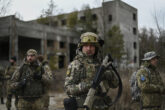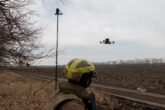August 20, 2021
From Forever Wars to Great-Power Wars: Lessons Learned from Operation Inherent Resolve
What lessons can be gleaned from recent U.S. military operations in Iraq and Syria that are relevant for a potential future war against a great-power adversary like China or Russia?
The U.S. Department of Defense is attempting to make the long overdue pivot from focusing on the Middle East to shoring up deterrence in the Indo-Pacific and Europe by improving its ability to prevail in large-scale combat against a great power. But it is important that the Pentagon does not relegate the lessons learned from its recent operational experience in the Middle East to the trash bin. Aaron Stein and Ryan Fishel argue that the U.S. Air Force needs to prepare for proxy war scenarios akin to Syria. The Defense Department undoubtedly should learn from its experience competing with Russia and Iran in Syria below the threshold of conventional war. But it can and should also learn lessons from U.S. operations in the Middle East for great-power conflict as well.
It is important that the Pentagon does not relegate the lessons learned from its recent operational experience in the Middle East to the trash bin.
The war to defeat the Islamic State in Iraq and the Levant (ISIL), known as Operation Inherent Resolve, presented one of the most permissive operating environments U.S. airpower could expect. Issues that emerged in this environment are likely to be far more acute against a more capable adversary. American military operations in the Middle East highlighted clear deficiencies in some missions that would be essential to winning a future great-power conventional war. U.S. forces should address the vulnerabilities identified during this conflict related to deliberate targeting, operating in contested airspace, and integrating air- and ground-based fires to prepare for future great-power conflict.
As the U.S. military prepares for war against a great power, military leaders have re-emphasized developing offensive platforms and weapons systems to improve firepower. Currently, U.S. air operations are centered around an air operations center that preplans deliberate airstrikes as a part of a 72-hour air-tasking cycle. In Operation Inherent Resolve, however, the deliberate targeting process routinely took “from days to weeks.” This proved to be too slow to keep up with a highly adaptive adversary and rapidly changing battlefield.
Read the full article from War on the Rocks.
More from CNAS
-
Defense / Transatlantic Security
When Defense Becomes Destruction: Austria-Hungary’s Mistake and Ukraine’s RiskThis article was originally posted on War on the Rocks. The southeastern Polish city of Przemyśl, with its elegant 19th century Habsburg-era train station, remains one of the ...
By Franz-Stefan Gady
-
Defense / Transatlantic Security
Ukraine’s Catch-22 MomentThis article was originally published in the Financial Times. In Joseph Heller’s wartime classic, Catch-22, the protagonist Yossarian seeks out the US army surgeon Doc Daneeka...
By Franz-Stefan Gady
-
CNAS Insights | Budgetary Own Goals Undermine “Speed and Volume”
On November 7, Secretary of Defense Pete Hegseth laid out a plan to overhaul the Department of Defense’s (DOD’s) acquisition system. Placing an emphasis on delivering new capa...
By Philip Sheers, Carlton Haelig & Stacie Pettyjohn
-
Drones: Who Is Making the New Weapons of War?
From Ukraine and Russia to Gaza and Sudan, drones have become a key weapon of war. Which companies are making them, and profiting from this rapidly expanding but controversial...
By Stacie Pettyjohn




